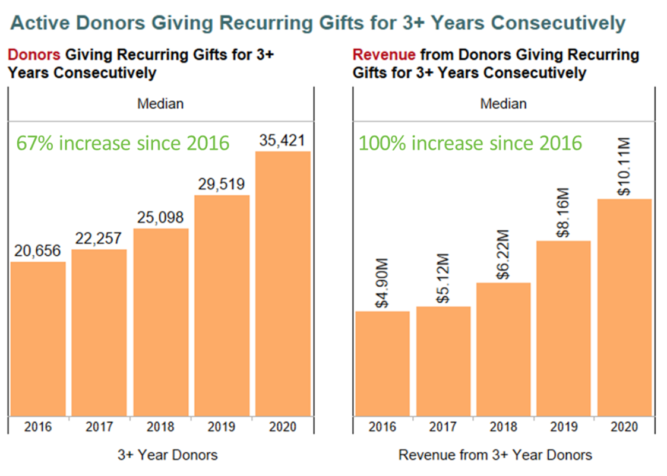Key Findings from the 2021 donorCentrics® Sustainer Summit

The seventh annual donorCentrics® Sustainer Summit brought together, via webinar, 31 of the nation’s largest national fundraising organizations to share results and discuss sustainer growth and retention strategies against the backdrop of the pandemic and other significant events that impacted donors and giving in 2020.
This year’s summit included data from a variety of sectors, drawn directly from participant CRMs and standardized to allow for consistent comparisons. The analysis is based on a July – June fiscal year, covering the period of FY2016 through FY2020. The data set included 16 million donors who gave 57 million gifts for a total of $2.4 billion in FY2020 (the donor count is the composite sum of each organization and will count donors multiple times who give to multiple organizations).
Donor and Revenue Growth in FY2020
In FY2020, both overall donors and revenue increased at the medians from FY2019. Overall donors increased by 7% and revenue increased by 4%. Though the share of donors making recurring gifts declined modestly from 18% in FY2019 to 17% in FY2020, the number of sustainers increased by 11% over the same period. Over the five-year report period, the share of recurring donors increased at the median from 15% to 17%:

In FY2020, 61% of all organizations experienced an increase in sustainers. After such a tumultuous year, with many drivers for both potential increases and declines in giving, it was no surprise to see mixed trends among sectors and organizational sizes.
Conversion from Single to Recurring Insights
As organizations increased the overall share of donors making single gifts in FY2020, converting these donors to sustainer giving will be a critical component of 2021 strategies. In FY2020, 65% of organizations increased the number of first-time recurring donors via conversion.
Emerging best practices for conversion at organizations with strong conversion metrics:
- The largest source for conversion in FY2020 was digital efforts with the most growth in email and digital ads. Telemarketing and direct mail followed.
- New donor conversion efforts occurred within 30 days, if not sooner.
- Automated e-mail donor welcome series included a conversion ask.
- To date, very little direct targeting of current donors happens related to converting these donors via digital techniques. The strategy was more often a blanketing technique, wherein all single gift donors receive frequent messages to convert.
- In direct mail, the conversion ask is included in most solicitations and as soon as within the gift acknowledgment letters.
- A lower ask amount may be necessary to convert more donors.
- Offering a premium can work for conversion, though careful monitoring of retention should be a part of the measured results.
New Sustainer Acquisition Trends
In FY2020, new donors increased at the median by 4% with a decline in the share of new donors making recurring gifts for nearly every sector and sustainer program size. As with overall donors, often the decline in the share of recurring donors was driven by a greater increase in the number of donors acquired as single gift donors. 45% of the organizations did acquire more recurring donors in FY2020 than in FY2019.
A big factor in the decline in share of sustainers among new donors in FY2020 was the pause in face-to-face and door-to-door solicitation brought on by the pandemic. Nearly every organization that uses these channels (half of all participating organizations) experienced a decline in face-to-face or door-to-door acquired donors in FY2020. Conversely, most participating organizations experienced an increase in donors acquired via digital channels. Digital advertising is the online channel with greatest growth both over time and in FY2020 for many organizations.

What new digital ad strategies or channels are organizations testing or considering for overall and sustainer acquisition?
- Connected TV
- Bolstering search marketing efforts and display
- TikTok and other social media sites beyond Facebook
- Airport video ads
- Retargeting video viewers with pre-roll ads and display banners
- QR codes
- Google ads
- Lightboxes or pop-ups on online forms that ask donors making single gifts to consider a recurring gift during the donation process continue to work well.
Sustainer Retention
A concern at the onset of the pandemic was a potential increase in current sustainers cancelling their gifts due to the stay-at-home orders and subsequent economic hardship and uncertainties. While many organizations reported an increase in cancellations in the early period of the closures, these quickly returned to more typical levels. Overall, 13–month retention rates (the share of donors giving 13 months following acquisition) for sustainers were stable from FY2019 to FY2020 at 59% for donors acquired directly as sustainers in the prior year.
The median retention rate for multi-year sustainers was 85% in FY2020. Compare to single gift multi-year retention of 57% and it is clear that beyond the first year, sustainer impact on overall donor retention is substantial. In fact, donors that have been giving sustainer gifts for 3 or more consecutive years will retain at rates of 95% – 98%. In FY2020, median counts of donors making sustainer gifts for 3 or more consecutive years increased by 20% and by 67% over the five-year period.

A key take-away of note for sustainer acquisition with possible retention implications included robust conversations around annual (or quarterly) sustainer offers. As payment methods, including EFT and PayPal expand, and credit card updater services and processes continue to improve, donors agreeing to make an annual on-going gift could potentially retain at far greater rates than single gift donors. But how they will compare to monthly donors will also be an important consideration before committing to this approach. We will watch for growth in this donor segment in 2021 and beyond.
Sustainer Stewardship
An area that was impacted by the stay-at-home orders was stewardship and the use of virtual campaigns to cultivate donor relationships in place of in-person events and meetings. Many organizations reported on virtual events and expanded uses of other techniques that they hope to continue in a post-pandemic world. These include:
- Virtual events that can be easily expanded to include sustainers and other donor groups or prospects
- Expanded use of vlogs
- Expanded use of texting, including thank-you’s and surveys
- Creating digital and offline impact reports for sustainers
- Using virtual tools to create a sense of community for sustainers
- Concierge call centers for sustainers
- Pre-recorded calls from co-founders
Sustainer Upgrades
Unlike many other key metrics, the share of recurring donors that upgraded their average gift did not increase in FY2020. Instead, we noted an ongoing downward trend. However, the share of recurring donors that made additional single gifts did increase for many organizations. Some are paying special attention to these donors, issuing special gift acknowledgements and hoping to encourage these gifts to continue in “non-emergency” periods.
Long Term Implications of Sustainer Giving
As our benchmarking data has borne out over time, we know that having a recurring giving strategy in place during a period of emergency or reactionary giving can greatly improve retention of donors that may otherwise be sporadic donors at best.
Trends since the last year of surge giving, FY2017, illustrate that those organizations with clear, direct and consistent messaging for sustainer acquisition during that turbulent year clearly benefitted from those donors’ rising rates of retention that followed versus declines in retention rates for emergency donors acquired with single gift donations. Half of the donors acquired as sustainers in FY2017 were still giving in FY2020, versus just 18% of those donors acquired as single gift donors at the same time.
It was clear in our data and in our conversation with summit participants that early investments and determination in building a solid core of extremely loyal recurring donors helped weather the challenges and embrace the opportunities of 2020.
